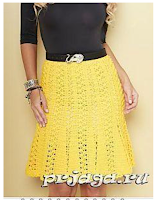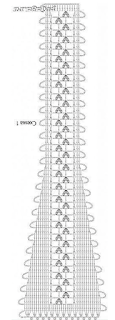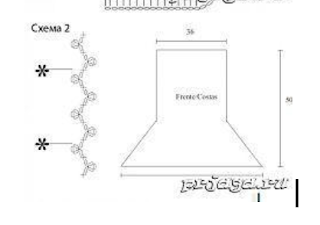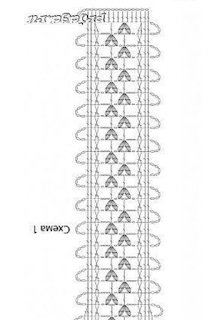This pattern has been on my to-do list for a really long time and I’m thrilled that it’s been chosen today. This is a very unusual construction – the skirt is worked in panels. So come along and let’s figure this one out 😀
In case you have just joined me, know that you can access all of my earlier creations by checking under ‘categories’ on the right hand side of this blog under “Labels”. Then, for your convenience, follow me here or on Facebook, You Tube, Pinterest, Twitter or Instagram.
Check out all my social media handles at the bottom of this blog
Oh, and may I add that the fastest way to find any of my blogs is via Pinterest.
All my blogs can be printed. Find the printer friendly (green) link on the right hand side of this blog. You can also hit Control P (or Command P for Mac) on your keyboard, and the blog will go directly to the connected printer.
Remember that you only print if absolutely essential. Save paper – Save Our Earth.
Do remember to add my blog URL when you make and show off your creation.
Just copy the link on the search bar above - that's the blog URL.
To purchase this or similar yarn online, click here to buy your yarns online via Amazon. While you will still pay the same, I may get paid by Amazon as well.
This is a free blog - so do pay it forward for me. Cheers.
Materials used : Today I’ve used ~ 350 gms of Bella Baby Tootgarook cotton 4-ply knitting cotton with a 3.5 mm crochet hook. (Hook suggested for this yarn is 3.25 mm)
For Indians : This yarn is the same thickness as our Anchor 4-ply or Laura knitting cottons.
Our lovely Indian White rose knitting cotton yarn is a good substitute. I’d also suggest Alize cotton yarn – and you can get all of this with a easy mouse click on the top right hand side of this blog (read : Click here to buy yarns Online)
For Non-Indians : I’ve purchased this yarn from Spotlight (Brisbane) and it’s a gorgeous yarn. Each ball is 50g / 1.76 oz and 159 yds / 145 m per ball.
International yarns that I think will work for this creation are Milford Satin knitting cotton, DMC Petra knitting cotton & Aunt Lydia Bamboo Viscose 10 knitting cottons.
Size made : Round waist : 35” ; Round hips 42” ; Full length : 22”
You can make this skirt to any size, using any yarn with a suitable hook.
I’m writing the size just for you to get yarn estimate.
Difficulty level : Advanced Skill level for the continuous tape motif pattern.
The rest of the skirt is Intermediate to Advanced skill level.
Double crochet 2-tog : dc 2-tog : [yo, insert hk in st or ch-sp, yo and pull up a lp ; yo and draw through 2 lps] 2 times (3 lps on hk) ;
{yo, draw through 2 lps on hk} 2 times. One dc 2-tog made.
This video tutorial at https://youtu.be/1_oPlUfN5eg shows you how to use the dc 2-tog to decrease.
Sometimes we work the dc 2-tog in the same stitch, to use as a decorative stitch. Visit this video tutorial at https://youtu.be/lLUXOJ1sY9wDouble crochet 3-tog : dc 3-tog : Here is an easy video tutorial at https://youtu.be/qlnqXDB3OUM
Double crochet 4-tog as a decorative stitch : dc 4-tog : Here is an easy video tutorial for working a dc 4-tog all in the same stitch as a decorative stitch at https://youtu.be/_B0-ye0cClU
Double crochet 4-tog as a decrease stitch : dc 4-tog : Here is an easy video tutorial for working a dc 4-tog over 4 sts at https://youtu.be/WjSNi7ithIU
Double crochet 4-tog as a decorative stitch : dc 4-tog : Here is an easy video tutorial for working a dc 4-tog all in the same stitch as a decorative stitch at https://youtu.be/_B0-ye0cClU
Part 1 : Measurements
You need to take the round waist, round hips and length of skirt
This pattern is not worked like other traditional patterns down from the waist. It is worked in panels down from the waist to the hemline. So the difference here is that you need to work one panel and then calculate how many panels you need.
So you can either choose to add in a zipper when you are joining your last two panels, or you can make the waist a little looser than needed, join it all together in a round, and then add in an elastic band at the top – or a belt cord.
Either way, you will continue the pattern repeats till you reach the length needed for your skirt
Part 2 : Skirt
As I mentioned right at the start of this blog, this skirt is worked in panels.
We start each panel from the waist and work down to the skirt hem.
Please work the pattern only for the length you need.
Unlike other patterns, this one is a bit tricky as you will need to fit your waist and hip measurements into the width and length of each panel.
So here’s what I suggest. Work one panel and then calculate how many panels you need to get the measurement you need.
Remember as we work each panel from top to down, you need to work it for the length you need for your skirt.
The pattern is given for a total skirt length of 50 cm / ~20”. Please bear this in mind when working your panels.
In case you want a longer panel, I’d suggest you just follow the pattern till the end, and then continue repeats of the last row till you get the length you need. I think this is the easiest method.
Along the sides of our panels we will be work ch-5 sps, and this is how we will join our panels.
So when you work the 2nd and all other panels, you will work ch 2, join to the earlier panel, ch 2 and continue working on the new panel. Got it?
But for now, let’s start on our first panel.
Foundation double crochet (fdc) : https://youtu.be/hjNUYVvyU9k
Start Row 1 : with 15 fdc. Turn.
Note 1 : The fdc is just a neat and easy way to start. In case you are stuck with it, then you could start with 15 fsc ; and then you will work 1 dc in each dc till end before you continue.
If the fsc also is a tedious one for you, please start with 17 chain. Then work your 1st dc in the 3rd ch from hook and work 1 dc all the way to the end.
Please count that you have 15 dc when you are done (to ensure that you have the right stitch count).
Note 2 : In our following row, we will work a dc 5-tog.
NOW depending on how thick your yarn is and how puffy this stitch looks, may I suggest you work either a dc 3-tog OR a dc 4-tog.
Easy video tutorials of all these stitches are given at the top of this blog.
For convenience, I am going to write the pattern as charted.
Double Crochet : dc : yo, insert hk into st ; yo (3 lps on hk);
[yo, draw through 2 lps] twice. One dc made.
Check out the video at https://youtu.be/xdnjB27zpYo
Chainless start for Double Crochet : I dislike the ch-2 / ch – 3 start, and this is what I do to start my row of dc.
Check out the video at https://youtu.be/wskv3iTjRx0
Double crochet 5-tog as a decrease stitch : dc 5-tog : Here is an easy video tutorial for working a dc 5-tog over 5 sts at https://youtu.be/Dh2viux_fBA
Double crochet 5-tog as a decorative stitch : dc 5-tog : Here is an easy video tutorial for working a dc 5-tog all in the same stitch as a decorative stitch at https://youtu.be/5806EIpgcV8
What is a chain stitch ? https://youtu.be/pXx5ukBjKkY
Row 2 : ch 5, dc in the 1st 2 fdc ;
2 dc in the next fdc ;
ch 3, sk next 2 fdc, dc in the next fdc ;
[ch 1, sk next 2 fdc, dc 5-tog in the next st ;
ch 2, dc 5-tog in the next st] ;
ch 1, sk next 2 fdc, 2 dc in the next fdc ;
dc in the last 2 fdc. Turn.
From this row on , we will work a “Cross stitch”. The cross stitch is worked over 2 dc. For this stitch, you skip the 1st st, and work a dc in Stitch # 2 first and then (turn and cross back over) and work the skipped Stitch #1.
You have now crossed 2 dc together, and this is our Cross stitch.
Row 3 : ch 5, dc in the 1st 2 dc ;
“Cross stitch” over the next 2 dc ;
ch 3, sk next dc 5-tog, dc in the next ch-2 sp (between the two dc 5-tog) ;
[ch 1, sk next st, dc 5-tog in the next dc ;
ch 2, dc 5-tog in the same dc] ;
ch 1, “Cross stitch” over the next 2 dc ;
dc in the last 2 dc. Turn.
Rows 4 – Row 26 : Rep Row 3
Note 3 : As I said before, this is an unusual construction, so we need to think unusual too. We are working the same pattern (without any change in width) for 25 rows. Please check that this will work for your waist and hip measurements.
In case you feel it is not working, may I suggest you work this pattern repeat only till where it suits you and then work Row 27 (which will be an increase row).
Row 27 : ch 5, 2 dc in the 1st dc ; dc in the next dc ;
“Cross stitch” over the next 2 dc ;
ch 3, sk next dc 5-tog, dc in the next ch-2 sp (between the two dc 5-tog) ;
[ch 1, sk next st, dc 5-tog in the next dc ;
ch 2, dc 5-tog in the same dc] ;
ch 1, “Cross stitch” over the next 2 dc ;
dc in the next dc ;
2 dc in the last dc. Turn.
Row 28 : ch 5, dc in the 1st 3 dc ;
“Cross stitch” over the next 2 dc ;
ch 3, sk next dc 5-tog, dc in the next ch-2 sp (between the two dc 5-tog) ;
[ch 1, sk next st, dc 5-tog in the next dc ;
ch 2, dc 5-tog in the same dc] ;
ch 1, “Cross stitch” over the next 2 dc ;
dc in the last 3 dc. Turn.
And this is what we’re going to do for a few rows..
Increase one stitch at each end of the panel every alternate row.
Just to clarify, let’s work on the next two rows together.
Row 29 : ch 5, 2 dc in the 1st dc ; dc in the next 2 dc ;
“Cross stitch” over the next 2 dc ;
ch 3, sk next dc 5-tog, dc in the next ch-2 sp (between the two dc 5-tog) ;
[ch 1, sk next st, dc 5-tog in the next dc ;
ch 2, dc 5-tog in the same dc] ;
ch 1, “Cross stitch” over the next 2 dc ;
dc in the next 2 dc ;
2 dc in the last dc. Turn.
Row 30 : ch 5, dc in the 1st 4 dc ;
“Cross stitch” over the next 2 dc ;
ch 3, sk next dc 5-tog, dc in the next ch-2 sp (between the two dc 5-tog) ;
[ch 1, sk next st, dc 5-tog in the next dc ;
ch 2, dc 5-tog in the same dc] ;
ch 1, “Cross stitch” over the next 2 dc ;
dc in the last 4 dc. Turn.
The pattern goes on this way till Row 48 (ending with a rep of Row 30).
However, as I mentioned at the start, as per the chart, this is for a skirt of length 50cm or 20”. I also told you at that time that you should work this pattern for as long as you want your skirt – so let’s do just that.
Go ahead and finish one panel till you are just 2 rows short of completion for your length.
How do you know you are 2 rows short of completion?
So measure the length you get with 2 rows (yes, gauge calculation) – and that will allow you to reach the length you need for your skirt and still be 2 rows short of completion.
The last 2 rows are going to be a bit general as we may have worked different number of stitches – so we will talk about the stitches before the “Cross stitch” and after it and the stitches in between the two dc 5-tog florets.
In this 2nd last row, we are not working a Cross st , but will work 1 dc in each of the legs of the Cross st – a regular dc. OK? Got it?
2nd last row : dc in all the stitches before the “Cross stitch” ;
dc in each of the 2 bars of the Cross stitch ;
(as many dc as there are chains in the next ch-sp) ; ; dc in the
How to work a picot stitch : Traditionally for a ch-3 picot, you work (ch 3, sl-st in 3rd ch from hook). For a ch-5 picot, you will do (ch 5, sl-st in 5th ch from hook).
Here’s a great video https://youtu.be/8s3zVaBcn4s
Last row : dc 4-tog over the 1st 4 dc ; (ch 1 + picot + ch 1 ; dc 3-tog over the next 3 dc) ; rep (to) all the way till the end.
Fasten off and weave in ends.
Now in case you have worked a different set of stitches and not followed the pattern, then I’d suggest that we tweak this last row a bit..
I’d suggest you count the stitches on that last row, and then work a dc 3-tog + the picot bit – without worrying about the pattern for this last row.
Enjoyed this ?? I sure did.. Come back right here for more freebie patterns
Remember to share this blog post when you share your photos with me on Facebook. I’d love to feature your photos on my FB page. Cheers.







No comments:
Post a Comment
Thanks for taking the time to stop by. Do tell me what you think. Cheers